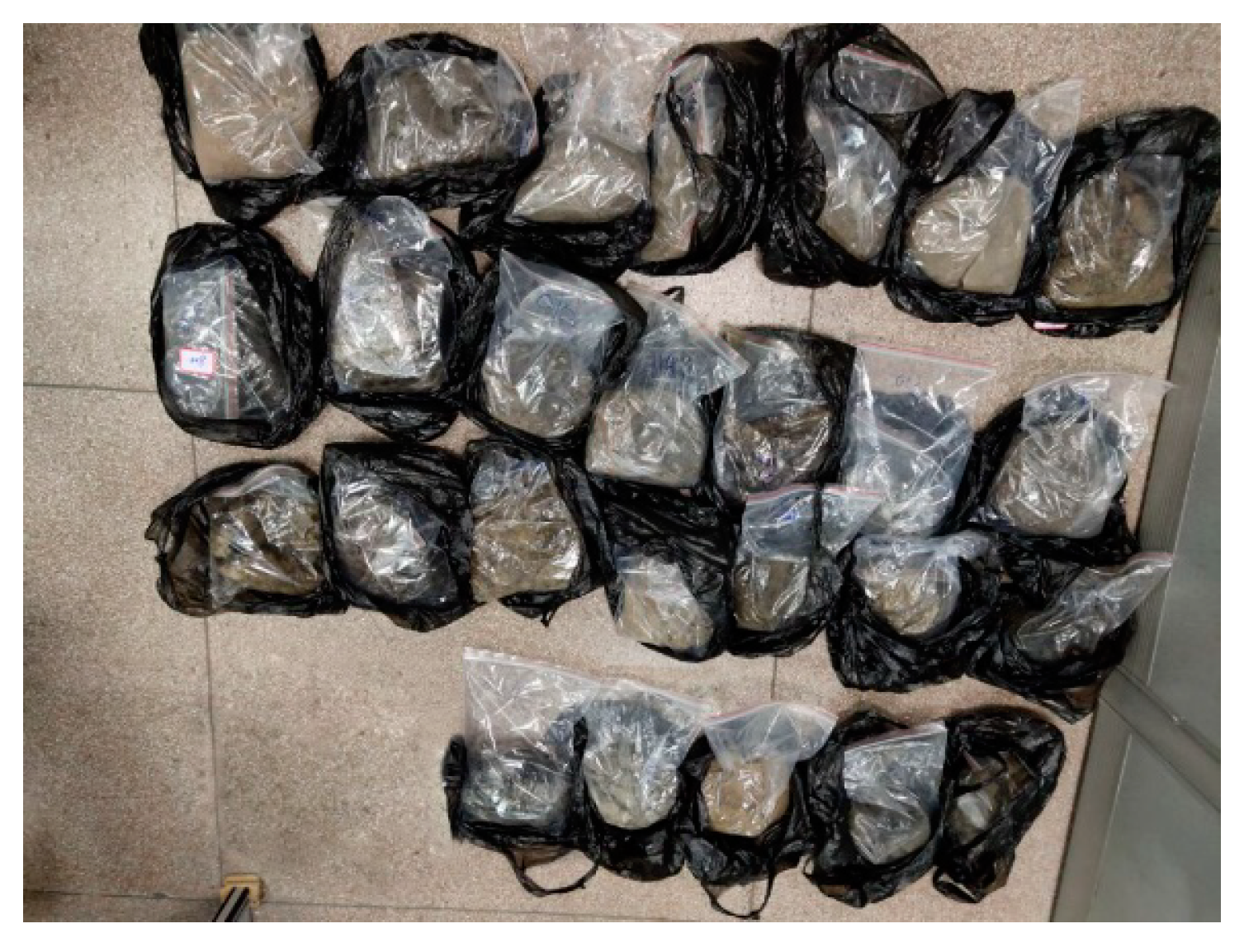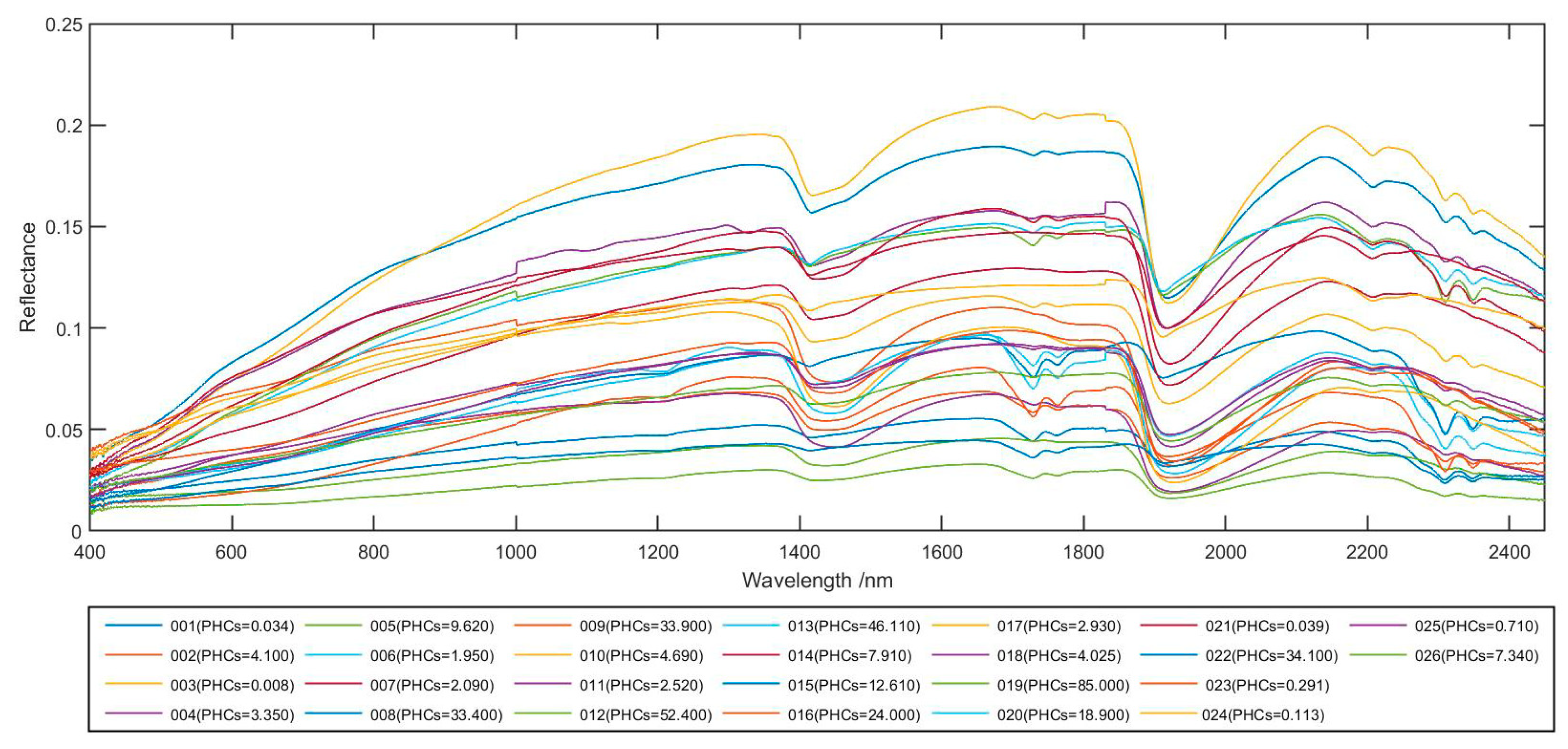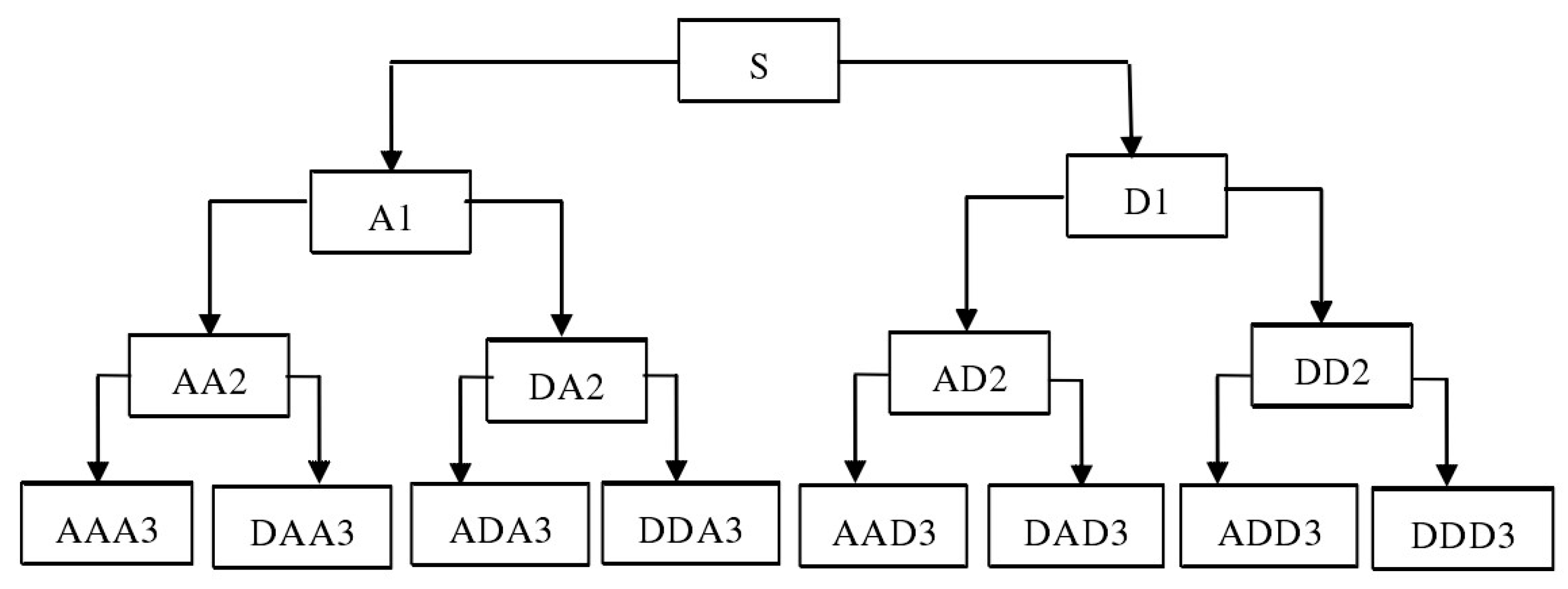Hyperspectral Inversion of Petroleum Hydrocarbon Contents in Soil Based on Continuum Removal and Wavelet Packet Decomposition
Abstract
:1. Introduction
2. Materials and Methods
2.1. Determination of PHCs
2.2. Spectral Measurement
2.3. Method
2.3.1. Continuum Removal
2.3.2. Daubechies 3 (db3) Wavelet Packet Decomposition
2.3.3. Pearson Correlation Analysis
2.3.4. PLSR
3. Results and Discussion
3.1. Spectral Analysis of Petroleum Hydrocarbons in Soil
3.2. Correlation Analysis of Soil Spectrum and PHCs
3.3. Petroleum Hydrocarbons Spectrum Prediction Model
4. Conclusion
- (1)
- CR-db3 three-layer decomposition can improve the correlation between the spectral reflectance and PHCs and effectively improve the spectrum sensitivity to PHCs.
- (2)
- Wavelet packet decomposition can improve the accuracy of the PHC prediction model in soil, where the accuracy of the obtained high-frequency spectrum modeling is higher than that of the low-frequency data.
- (3)
- Obtaining high-frequency information based on the CR-db3 processed spectrum can improve the prediction accuracy of PHCs. The PHC model constructed by this preprocessing method is optimal (R2 = 0.977, RMSEC = 3.078, RMSECV = 4.727, RMSEP = 4.498, RPD = 6.16).
Author Contributions
Funding
Acknowledgments
Conflicts of Interest
Appendix A
| Number | Longitude Latitude | PHCs (mg/kg) |
|---|---|---|
| 001 | 124°39’52.17”E 45°45’45.95”N | 34.3 |
| 002 | 124°39’0.50” E 45°45’1.25” N | 4100 |
| 003 | 124°38’14.48” E 45°45’8.30” N | 8.08 |
| 004 | 124°38’27.90” E 45°44’55.42” N | 3350 |
| 005 | 124°38’30.29” E 45°44’26.33” N | 9620 |
| 006 | 124°38’41.50” E 45°43’24.91” N | 1950 |
| 007 | 124°38’50.88” E 45°42’46.08” N | 2090 |
| 008 | 124°39’4.99” E 45°42’29.06” N | 33400 |
| 009 | 124°39’23.42” E 45°43’14.21” N | 33900 |
| 010 | 124°39’31.58” E 45°43’8.08” N | 4690 |
| 011 | 124°39’45.21” E 45°42’41.35” N | 2520 |
| 012 | 124°39’41.43” E 45°42’12.00” N | 52400 |
| 013 | 124°40’23.31” E 45°44’55.42” N | 46110 |
| 014 | 124°40’39.19” E 45°44’47.29” N | 7910 |
| 015 | 124°40’6.45” E 45°44’4.12” N | 12610 |
| 016 | 124°40’14.13” E 45°42’37.05” N | 24000 |
| 017 | 124°40’30.04” E 45°42’28.58” N | 2930 |
| 018 | 124°39’53.38” E 45°41’2.20” N | 4025 |
| 019 | 124°39’26.28” E 45°41’40.69” N | 85000 |
| 020 | 124°38’58.33” E 45°41’22.04” N | 18900 |
| 021 | 124°38’44.03” E 45°41’22.00” N | 39.3 |
| 022 | 124°38’57.63” E 45°41’2.60” N | 34100 |
| 023 | 124°39’25.78” E 45°41’7.70” N | 291 |
| 024 | 124°38’37.23” E 45°40’58.38” N | 113 |
| 025 | 124°39’10.87” E 45°40’23.44” N | 710 |
| 026 | 124°39’48.02” E 45°40’37.36” N | 7340 |
References
- Sanin, P.I. Petroleum Hydrocarbons. Chem. Environ. 1976, 45, 684–700. [Google Scholar] [CrossRef]
- Li, M.; Wang, C.; Xie, S.B. Chinese Journal of Rock Mechanics and Engineering. Chin. J. Rock Mech. Eng. 2019, S1, 3252–3261. [Google Scholar]
- Grant, C. Soils and Human Health. J. Environ. Qual. 2013, 42, 1909–1910. [Google Scholar] [CrossRef] [PubMed]
- Yu, C.H. Review of Soil Pollution in Petrochemical Industry. Contemp. Chem. Ind. 2019, 48, 2385–2387, 2423. [Google Scholar]
- Chen, Z.L.; Yin, W.Y.; Liu, H.T.; Liu, Q.; Yang, Y. Review of Monitoring Petroleum-Hydrocarbon Contaminated Soils with Visible and Near-Infrared Spectroscopy. Spectrosc. Spectr. Anal. 2017, 37, 1723–1727. [Google Scholar]
- Balabin, R.; Sieve, R. Capabilities of near infrared spectroscopy for the determination of petroleum macromolecule content in aromatic solutions. J. Near Infrared Spectrosc. 2007, 15, 343–349. [Google Scholar] [CrossRef]
- Chakraborty, S.; Weindorf, D.C.; Morgan, C.L.; Ge, Y.; Galbraith, J.M.; Li, B.; Kahlon, C.S. Rapid Identification of Oil-Contaminated Soils Using Visible Near-Infrared Diffuse Reflectance Spectroscopy. J. Environ. Qual. 2010, 39, 1378–1387. [Google Scholar] [CrossRef]
- Angelopoulou, T.; Balafoutis, A.; Zalidis, G.; Bochtis, D. From Laboratory to Proximal Sensing Spectroscopy for Soil Organic Carbon Estimation—A Review. Sustainability 2020, 12, 443. [Google Scholar] [CrossRef] [Green Version]
- YI, W.Q.; Chen, Z.L.; Jiao, Y.W.; Liu, Q. Research on Visible-Near Infrared Spectral Characterization of Purplish Soil Contaminated with Petroleum Hydrocarbon and Estimation of Pollutant Content. Spectrosc. Spectr. Anal. 2017, 37, 3924–3931. [Google Scholar]
- Cloutis, E.A. Spectral Reflectance Properties of Hydrocarbons: Remote-Sensing Implications. Science 1989, 245, 165–168. [Google Scholar] [CrossRef] [Green Version]
- Yang, Z.; Wang, Y.T.; Chen, Z.K.; Liu, T.-T.; Shang, F.-K.; Wang, S.-T.; Cheng, P.-F.; Wang, J.-Z.; Pan, Z. Determination of Petroleum Pollutants by Four Dimensional Fluorescence Spectra Based on Temperature Variable. Spectrosc. Spectr. Anal. 2019, 39, 2546–2553. [Google Scholar]
- Ren, H.Y.; Shi, X.Z.; Zhuang, D.F.; Xu, X.L.; Jiang, D.; Yu, X.F. Visible-near-infrared Spectroscopy in Estimation of Petroleum Hydrocarbon Concentration in Soil. Soils 2013, 2, 1295–1300. [Google Scholar]
- Scafutto, R.D.P.M.; Souza, F.; Carlos, R.D. Quantitative characterization of crude oils and fuels in mineral substrates using reflectance spectroscopy: Implications for remote sensing. Int. J. Appl. Earth. Obs. Geo. 2016, 50, 221–242. [Google Scholar] [CrossRef]
- Chakraborty, S.; Weindorf, D.C.; Zhu, Y.; Li, B.; Morgan, C.L.; Ge, Y.; Galbraith, J. Spectral reflectance variability from soil physicochemical properties in oil contaminated soils. Geoderma 2012, 177, 80–89. [Google Scholar] [CrossRef]
- Fan, Y.G.; Zhang, L. Soil oil content hyperspectral model in Gudong Oilfield. J. Remote Sens. 2012, 16, 378–389. [Google Scholar]
- Rosa, E.C.P.; Carlos, R.S.F. Spectroscopic characterization of red latosols contaminated by petroleum-hydrocarbon and empirical model to estimate pollutant content and type. Remote Sens. Environ. 2016, 175, 323–336. [Google Scholar]
- Yang, M.; Xu, D.; Chen, S.; Li, H.; Shi, Z. Evaluation of Machine Learning Approaches to Predict Soil Organic Matter and pH Using vis-NIR Spectra. Sensors 2019, 19, 263. [Google Scholar] [CrossRef] [Green Version]
- Forrester, S.T.; Janik, L.J.; McLaughlin, M.J.; Soriano-Disla, J.M.; Stewart, R.; Dearman, B. Total Petroleum Hydrocarbon Concentration Prediction in Soils Using Diffuse Reflectance Infrared Spectroscopy. Soil Sci. Soc. Am. J. 2013, 77, 450–460. [Google Scholar] [CrossRef] [Green Version]
- Sorak, D.; Herberholz, L.; Iwascek, S.; Altinpinar, S.; Pfeifer, F.; Siesler, H.W. New Developments and Applications of Handheld Raman, Mid-Infrared, and Near-Infrared Spectrometers. Appl. Spectrosc. Rev. 2012, 47, 83–115. [Google Scholar] [CrossRef]
- Wang, Y.C.; Yang, X.F.; Zhao, Q.C.; Gu, X.-H.; Guo, C.; Liu, Y.-P. Quantitative Inversion of Soil Organic Matter Content in Northern Alluvial Soil Based on Binary Wavelet Transform. Spectrosc. Spectr. Anal. 2019, 39, 2855–2861. [Google Scholar]
- Yu, W.; Zang, S.; Wu, C.; Liu, W.; Na, X. Analyzing and modeling land use land cover change (LUCC) in the Daqing City, China. Appl. Geogr. 2011, 31, 600–608. [Google Scholar] [CrossRef]
- Mu, S.J. Zhaoyuan County Soil and Evolution Trend. Soils 1981, 01, 11–13. [Google Scholar]
- Liu, Y.; Wei, D.; Li, Y.T.; Zhang, M.Y.; Hang, G. Study on Nutrient Distribution of Soil Profiles of Main Soil Type in Heilongjiang Province. Heilongjiang Agric. Sci. 2015, 11, 31–34. [Google Scholar]
- Bai, J.W.; Li, X.; Hu, X.T.; Zhang, X.F.; Zhao, Y.C.; Zhang, B.; Tong, Q.X.; Zheng, L.F. Study on the Classification Methods of the Hyperspectral Image Based on the Continuum Removed. Comput. Eng. Appl. 2003, 88, 128. [Google Scholar]
- Cécile, G.; Philippe, L.; Guillaume, G. Continuum removal versus PLSR method for clay and calcium carbonate content estimation from laboratory and airborne hyperspectral measurements. Geoderma 2008, 148, 141–148. [Google Scholar]
- Chen, J.Y.; Xing, Z.; Zhang, Z.T.; Lao, C.C.; Li, X.W. Comprehensive Evaluation of Waste Water Quality Based on Quantitative Inversion Model Hyperspectral Technology. Trans. Chin. Soc. Agric. Mach. 2019, 11, 200–209. [Google Scholar]
- Wang, X.; Shi, T.; Liao, G.; Zhang, Y.; Hong, Y.; Chen, K. Using Wavelet Packet Transform for Surface Roughness Evaluation and Texture Extraction. Sensors 2017, 17, 933. [Google Scholar] [CrossRef]
- Lee, M.J.; Temple, M.A.; Claypoole, R.L.; Raines, R.A. Transform domain communications and interference avoidance using wavelet packet decomposition. In Proceedings of the IEEE Wireless Communications and Networking Conference Record, Orlando, FL, USA, 17–21 March 2002. [Google Scholar]
- Fang, S.; Yang, M.; Zhao, X.; Guo, X. Spectral Characteristics and Quantitative Estimation of SOM in Red Soil Typical of Ji’an County, Jiangxi Province. Acta Pedol. Sin. 2014, 51, 1003–1010. [Google Scholar]
- Lu, X.T. Partial Least Squares Regression Modelsand Algorithms Research. Master’s Thesis, North China Electric Power University, Beijing, China, 2014. [Google Scholar]
- Jiang, H.W.; Xia, J.L. Partial least square and its application. J. Fourth Mil. Med. Univ. 2003, 24, 280–283. [Google Scholar]
- Chen, S.B.; Hu, Z.; Zhang, X.Q.; Ren, W. Application of Software Technology in Quantitative Analysis of Near Infrared Spectroscopy. Chin. J. Chem. Educ. 2018, 39, 62–67. [Google Scholar]
- Peng, X.T.; Gao, X.W.; Wang, J.J. Inversion of Soil Parameters from Hyperspectra Based on Continuum Removal and Partial Least Squares Regression. Geomat. Inf. Sci. Wuhan Univ. 2014, 39, 862–866. [Google Scholar]
- Scafutto RD, P.M.; de Souza Filho, C.R.; de Oliveira, W.J. Hyperspectral remote sensing detection of petroleum hydrocarbons in mixtures with mineral substrates: Implications for onshore exploration and monitoring. ISPRS J. Photogramm. Remote Sens. 2017, 128, 146–157. [Google Scholar] [CrossRef]
- Maleki, M.R.; Van Holm, L.; Ramon, H.; Merckx, R.; De Baerdemaeker, J.; Mouazen, A.M. Phosphorus Sensing for Fresh Soils using Visible and Near Infrared Spectroscopy. Biosyst. Eng. 2006, 95, 425–436. [Google Scholar] [CrossRef]
- Wang, X.C.; Tian, A.J.; Guan, Z. The extraction of oil and gas information by using hyperion imagery in the SeBei gas field. Remote Sens. Land Resour. 2017, 1, 36–40. [Google Scholar]
- Ying, C.; Ming, Y.K.; Yu, G.T.; Lu, T.-Y.; Shi, H.-Z. Method on Monitoring Oil Pollution Information of Soil Based on the Hyperspectral Remote Sensing. Sci. Technol. Eng. 2018, 18, 92–98. [Google Scholar]











| Sample Number | Max | Min | Average | Standard Deviation | |
|---|---|---|---|---|---|
| PHCs (g/kg) | 26 | 85 | 0.008 | 15.082 | 20.569 |
| Spectral Preprocessing Models | Important Variables | R2 | RMSEC (g/kg) | RMSECV (g/kg) | RMSEP (g/kg) | RPD |
|---|---|---|---|---|---|---|
| Initial spectrum | 456–524, 1886–189, 1995–2033, 2278–2371 nm | 0.422 | 12.358 | 16.565 | 22.528 | 1.01 |
| Db3 to low-frequency spectrum | 502–524, 1887–189, 1997–203, 2285–2368 nm | 0.423 | 11.360 | 15.813. | 20.534 | 1.06 |
| Db3 to high-frequency spectrum | 483, 697, 701, 872–883, 1387–1440, 1552–1565, 1898–1932, 2202–2220 nm etc. | 0.818 | 8.800 | 9.189 | 12.804 | 2.33 |
| After-continuum removal spectrum | 1186–1254, 1682–1843, 2202–2226, 2250–2448 nm | 0.918 | 5.888 | 7.971 | 10.662 | 3.29 |
| Db3 to low-frequency spectrum | 469–474, 835–869, 1185–1307, 2224–2232 nm | 0.951 | 4.578 | 5.147 | 6.952 | 3.38 |
| Db3 to high-frequency spectrum | 441–443, 447–483, 686–740, 1423–1441, 1683–1716, 2257–2296, 2400 nm etc. | 0.977 | 3.078 | 4.727 | 4.498 | 6.16 |
© 2020 by the authors. Licensee MDPI, Basel, Switzerland. This article is an open access article distributed under the terms and conditions of the Creative Commons Attribution (CC BY) license (http://creativecommons.org/licenses/by/4.0/).
Share and Cite
Chen, C.; Jiang, Q.; Zhang, Z.; Shi, P.; Xu, Y.; Liu, B.; Xi, J.; Chang, S. Hyperspectral Inversion of Petroleum Hydrocarbon Contents in Soil Based on Continuum Removal and Wavelet Packet Decomposition. Sustainability 2020, 12, 4218. https://doi.org/10.3390/su12104218
Chen C, Jiang Q, Zhang Z, Shi P, Xu Y, Liu B, Xi J, Chang S. Hyperspectral Inversion of Petroleum Hydrocarbon Contents in Soil Based on Continuum Removal and Wavelet Packet Decomposition. Sustainability. 2020; 12(10):4218. https://doi.org/10.3390/su12104218
Chicago/Turabian StyleChen, Chaoqun, Qigang Jiang, Zhenchao Zhang, Pengfei Shi, Yan Xu, Bin Liu, Jing Xi, and ShouZhi Chang. 2020. "Hyperspectral Inversion of Petroleum Hydrocarbon Contents in Soil Based on Continuum Removal and Wavelet Packet Decomposition" Sustainability 12, no. 10: 4218. https://doi.org/10.3390/su12104218





